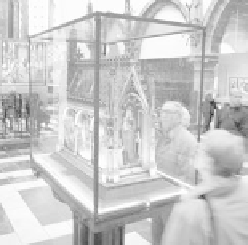Travel Reference
In-Depth Information
St. Ursula Shrine
(c. 1489)
On October 21, 1489, the mortal remains of St. Ursula were brought
here to the church and placed in this gilded oak shrine, built spe-
cially for the occasion and decorated
with paintings by Memling. Ursula,
yet another Christian martyred by the
ancient Romans, became a sensation
in the Middle Ages when builders in
Germany's Köln (Cologne) unearthed a
huge pile of bones believed to belong to
her and her 11,000 slaughtered cohorts.
The shrine, carved of wood and
covered with gold, looks like a min-
iature Gothic church (similar to the
hospital church). Memling was asked to fill in the “church's”
stained-glass windows with six arch-shaped paintings telling
Ursula's well-known legend.
• Stand in the middle of the room, facing the shrine. “Read” the shrine's
story from left to right, circling counterclockwise, but begin with the...
Left Panel:
Ursula—in white and blue—arrives by boat at the
city of Köln and enters through the city gate. She's on a pilgrim-
age to Rome, accompanied by 11,000 (female) virgins. That night
(look in the two windows of the house in the background, right),
an angel appears and tells her this trip will mean her death, but she
is undaunted.
Center Panel:
Continuing up the Rhine, they arrive in Basel.
(Memling knew the Rhine, having grown up near it.) Memling
condenses the 11,000 virgins to a more manageable 11, making
each one pure enough for a thousand. From Basel, they set out on
foot (in the background, right) over the snowy Alps.
Right Panel:
They arrive in Rome—formally portrayed by
a round Renaissance tower decorated with
putti
(little angels)—
where Ursula falls to her knees before the pope at the church steps.
Kneeling behind Ursula is her fiancé, Etherus, the pagan prince
of England. She has agreed to marry him only if he becomes a
Christian and refrains from the marriage bed long enough for her
to make this three-year pilgrimage as a virgin (making, I guess,
number 11,001). Inside the church on the right side, he is baptized
a Christian.
Opposite Side—Left Panel:
They head back home. Here,
they're leaving Basel, boarding ships to go north on the Rhine.
he pope was so inspired by these virgins that he joined them.
These “crowd” scenes are hardly realistic—more like a collage
of individual poses and faces. And Memling tells the story with
extremely minimal acting. Perhaps his inspiration was the pomp
and ceremony of Bruges parades, which were introduced by the




















